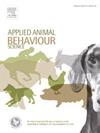Effects of tactile stimulation and application of umbilical antiseptic on the welfare of pre-weaned beef calves
IF 2.2
2区 农林科学
Q1 AGRICULTURE, DAIRY & ANIMAL SCIENCE
引用次数: 0
Abstract
The objectives of the current study were to investigate the impacts of tactile stimulation and application of umbilical antiseptic in newborn beef calves on 1) reactivity when interacting with humans in handling facilities, and 2) risk of disease treatment, mortality, and average daily gain (ADG). A total of 120 calves (65 males and 55 females) were randomly allocated into one of four experimental groups: TSUA) calves with tactile stimulation and application of umbilical antiseptic; TS) calves with tactile stimulation but no application of umbilical antiseptic; UA) calves without tactile stimulation but with application of umbilical antiseptic, and C) control, calves without tactile stimulation or application of umbilical antiseptic. Welfare was assessed using behavioural indicators (calf reactivity during weighing inside the cage (RDW), reactivity inside the squeeze chute (RSC), flight speed (FS), and avoidance distance (AD)), health (treatment for disease and death from birth to pre-weaning), and productivity (ADG in two periods, ADG1 and ADG2). A factor analyses with varimax rotation was performed to analyse behaviours composing RDW, generating 4 principal components (PC) (elevated responsiveness, vigilance activity, agitation response, and vocalization) with eigenvalues exceeding 1 and together explaining a total of 67 % of the total variance. To evaluate the differences in calves' RDW PC’s scores, RSC, FS, AD, ADG1, and ADG2 among experimental groups, generalized linear mixed models were performed. Fisher's tests were performed for health indicators to investigate the association between the experimental groups and the occurrence of Neonatal Calf Diarrhea (NCD), Bovine Respiratory Disease (BRD), or both (DBRD). Only FS had a significant association with the experimental groups (P < 0.001), with the lowest mean ± SE for TS (1.10 ± 0.03) compared with TSUA (1.23 ± 0.03, P = 0.01), UA (1.22 ± 0.04, P = 0.02), and C (1.22 ± 0.03, P = 0.02), which did not differ from each other (P > 0.05). Other behavioural indicators did not differ among experimental groups (P > 0.05). Likewise, there was no significant association of experimental groups with health or productivity indicators (P > 0.05). In conclusion, the application of tactile stimulation early in beef calves' lives was associated with a decrease in one of the four reactivity tests evaluated (FS). While the evidence of a broader impact on calf welfare is limited because other welfare indicators were not affected by the interventions, these results suggest that tactile stimulation could positively influence reactivity in a specific scenario.
触觉刺激及脐部抗菌剂的应用对断奶前肉牛福利的影响
本研究的目的是研究触觉刺激和脐带消毒剂对新生牛肉犊牛的影响:1)在处理设施中与人类互动时的反应性;2)疾病治疗风险、死亡率和平均日增重(ADG)。试验选用120头犊牛(公65头,母55头),随机分为4个实验组:tua组犊牛给予触觉刺激并应用脐部抗菌剂;TS)小牛有触觉刺激,但不应用脐部防腐剂;UA)没有触觉刺激但应用脐部抗菌剂的犊牛,C)对照组,没有触觉刺激或应用脐部抗菌剂的犊牛。使用行为指标(犊牛在笼内称重时的反应性(RDW)、挤压槽内的反应性(RSC)、飞行速度(FS)和躲避距离(AD))、健康(从出生到断奶前的疾病和死亡治疗)和生产力(ADG1和ADG2两个时期的ADG)来评估福利。对构成RDW的行为进行了变量旋转因子分析,产生了特征值超过1的4个主成分(PC)(反应性升高、警戒活动、躁动反应和发声),总共解释了总方差的67 %。为了评估犊牛RDW PC评分、RSC、FS、AD、ADG1和ADG2在实验组之间的差异,采用广义线性混合模型。对健康指标进行Fisher检验,以调查实验组与新生牛犊腹泻(NCD)、牛呼吸道疾病(BRD)或两者兼而有之(DBRD)的发生之间的关系。只有FS重大协会与实验组织(P & lt; 0.001),意味着最低的± SE为TS(1.10 ±0.03 )与TSUA(1.23 ± 0.03,P = 0.01),UA(1.22 ± 0.04,P = 0.02),C(1.22 ± 0.03,P = 0.02),没有相互之间的差别(P 祝辞 0.05)。其他行为指标各组间差异无统计学意义(P >; 0.05)。同样,实验组与健康或生产力指标也没有显著关联(P >; 0.05)。总之,在犊牛生命早期应用触觉刺激与四项反应性测试评估(FS)中的一项降低有关。虽然由于其他福利指标没有受到干预的影响,因此对小牛福利产生更广泛影响的证据有限,但这些结果表明,在特定情况下,触觉刺激可以积极影响反应性。
本文章由计算机程序翻译,如有差异,请以英文原文为准。
求助全文
约1分钟内获得全文
求助全文
来源期刊

Applied Animal Behaviour Science
农林科学-行为科学
CiteScore
4.40
自引率
21.70%
发文量
191
审稿时长
18.1 weeks
期刊介绍:
This journal publishes relevant information on the behaviour of domesticated and utilized animals.
Topics covered include:
-Behaviour of farm, zoo and laboratory animals in relation to animal management and welfare
-Behaviour of companion animals in relation to behavioural problems, for example, in relation to the training of dogs for different purposes, in relation to behavioural problems
-Studies of the behaviour of wild animals when these studies are relevant from an applied perspective, for example in relation to wildlife management, pest management or nature conservation
-Methodological studies within relevant fields
The principal subjects are farm, companion and laboratory animals, including, of course, poultry. The journal also deals with the following animal subjects:
-Those involved in any farming system, e.g. deer, rabbits and fur-bearing animals
-Those in ANY form of confinement, e.g. zoos, safari parks and other forms of display
-Feral animals, and any animal species which impinge on farming operations, e.g. as causes of loss or damage
-Species used for hunting, recreation etc. may also be considered as acceptable subjects in some instances
-Laboratory animals, if the material relates to their behavioural requirements
 求助内容:
求助内容: 应助结果提醒方式:
应助结果提醒方式:


